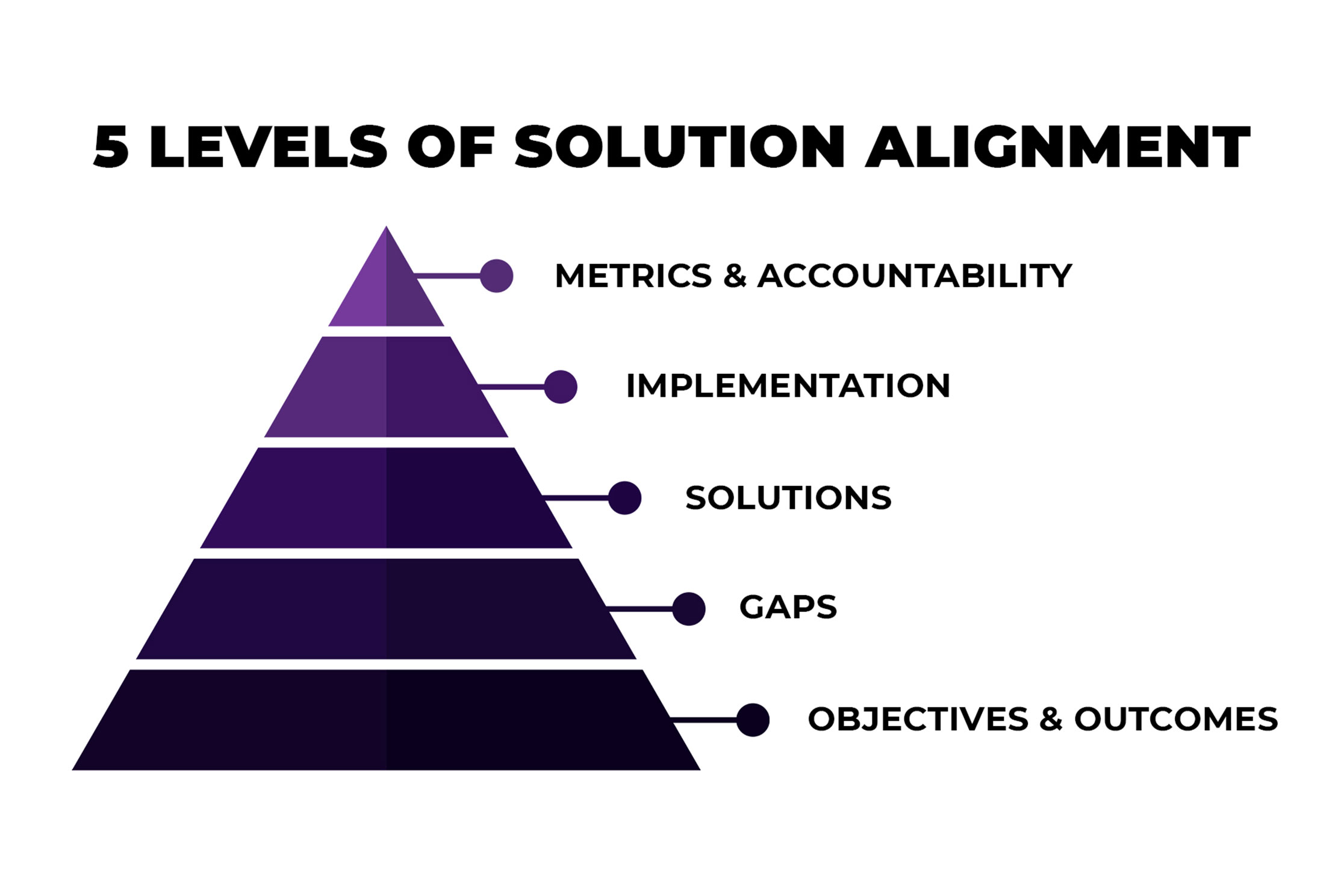
Solution Alignment Pyramid: How to Get Your Teams On The Same Page
Innovation projects often need teams of people to participate in conceiving, designing, building, testing, marketing, and selling a solution.
But the open nature of generating new ideas means team members may disagree on what to focus on or how to accomplish it. For example, when developing a new product, one faction may want to change the form of the product, while another wants to focus on its features, and yet another on its pricing model or distribution methods.
Gaining alignment around these types of disagreements is essential to proceeding toward a business outcome. At our company, FROM Vision to Victory, we have often observed client teams becoming “stuck” on certain important decisions, and it becomes difficult to drive an initiative forward because team members are not moving towards agreement.
Spending a lot of time working to facilitate alignment in these types of situations led us to an important insight that has served us ever since.
We observed that there are around five different “levels” of decision-making associated with digital or innovation initiatives, as outlined below, and disagreements can occur at any of the levels.

But most importantly, we observed that when discussions are not progressing, it’s usually because the conversation is not really occurring where the level of disagreement is. For example, if the disagreement is about what features to include in a product, but the team has different ideas about whom the product is meant for or what its main benefit to those users is meant to be, they are unlikely to come to an agreement if the discussion focuses on debating the merits of the features.
Instead, the team needs to realize that they have a more basic disagreement and focus on debating the pros and cons of how to position the product and for whom. Once this is resolved, it serves as a lens for evaluating higher-level questions (in this case, features), and very often when the lower-level dispute is resolved, the answer to the higher-level question becomes obvious and that conflict disappears.
Let’s take a look at the five-level Solution Alignment Pyramid and closely examine each level, starting from the bottom and going up.
LEVEL ONE: OBJECTIVES AND OUTCOMES

You need to start with a mission. What is the outcome your business is seeking? If the team is working on an innovation project, what’s the end goal?
For you, it could be to expand the product to more platforms. Meanwhile, for other team members, it could be to grow market share, increase profitability, or respond to a specific competitive offer. While these goals may not be completely contradictory and similar actions may support all of them, these are still different goals, and deciding which one is the most important will form the basis for higher-level decisions because team members focusing on different goals are likely to have different priorities at higher levels.
LEVEL TWO: GAPS

Once alignment is established on the outcomes, then the team needs to figure out what factors are blocking those outcomes (i.e., the gaps). Why have we not already achieved our goals? What changes are needed to get there?
This is where the second level of the pyramid comes in. What exactly are the problems in the current business operations and customer experience, and which of these problems should be targeted through innovation?
For instance, the team may be aligned on the main objective of expanding market share but they disagree on what issues need to be addressed to achieve this goal. Some team members may think that the main problem is the lack of brand awareness, but for others, the bigger issue could be the poor digital usability or missing features.
LEVEL THREE: SOLUTIONS

Even when the team is aligned on what the gaps are, they may diverge on the most effective solutions to bridge those gaps. Alignment around solutions is key to making the best choices and gaining consensus around how you’ll solve the problem.
In the previous example, the team may have aligned on poor digital customer experience as the main gap that needs to be fixed, but they still need to agree on which solutions to focus on. Some team members may want to redesign the navigation, others focus on adding voice recognition and yet others may feel that improving the overall speed of the product is the best way to close the "customer experience gap."
LEVEL FOUR: IMPLEMENTATION

eams might all agree on the solution but maybe not on how to actually execute it. Debates often arise when discussing resource allocation, timelines, and responsibilities. Alignment at this level is crucial to ensure a smooth and coordinated execution.
For example, adding voice and image recognition may be the agreed-upon solution to improve the digital experience but the team may disagree about whether this initiative should be worked on by internal teams or outsourced to an external firm or about which technology tools to use to deliver the result.
LEVEL FIVE: METRICS AND ANALYTICS
After reaching an agreement on the first four levels, the team then needs to align on how the success of the innovation will be defined, measured, and monitored. Which metrics can best show the progress and areas for improvement of the initiative? Who will be accountable for monitoring and reporting on its success?
In the above example, once the app is built and launched, there may still be debates on which key metrics to focus on to determine whether the new digital solution really enhanced the customer experience. Should it be conversion rate, average order value, bounce rate, or customer reviews and ratings?
Working through all 5 levels from the bottom up is often the best approach. If there is already strong alignment on lower levels, the conversation will be extremely rapid, however if there isn't, catching that before you begin potentially frustrating discussions at higher levels can avoid a lot of wasted time and energy.
And remember ,disagreement is not inherently bad. In fact, the process of teams debating alternatives and working through solutions, if executed in a positive manner, is helpful for achieving a superior outcome and getting teams really invested in the results.
The Solution Alignment Pyramid is meant to help make that process a bit more structured and productive. The disagreements may not be easy to overcome, and compromise might be needed, but you can finally start to make progress when you are actually talking about the issue at the right level.
What roadblocks do you encounter in driving alignment? Let’s talk. Book a call with us now.